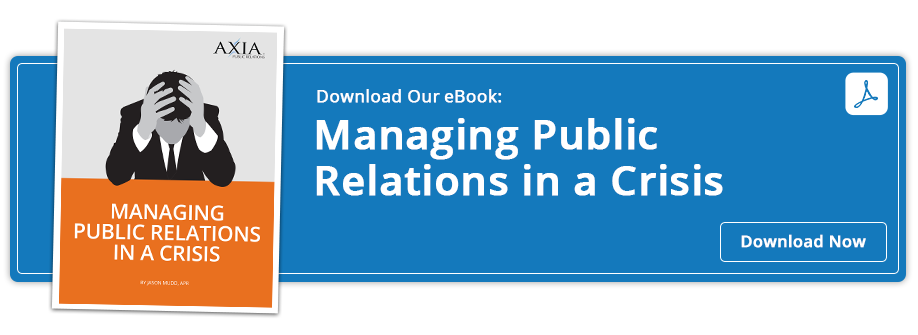 Let PR show you how you can benefit from disaster
Let PR show you how you can benefit from disaster
President John F. Kennedy remarked, “When written in Chinese, the word ‘crisis’ is composed of two characters. One represents danger and the other represents opportunity.” A crisis typically indicates that something was wrong and has now reached the stage where you can no longer ignore it. Still, it is also a chance to make changes and make things right.
After a crisis, you must quickly assess the situation and determine what you can learn from it. PR can help with this process.
The real deal about crises
Every company, at some point in its lifetime, will face a crisis, and studies have shown that more than 40 percent of companies in these situations don’t survive them. With so many news stories about companies in crisis, it’s time to get your head out of the sand and stop thinking that crises only happen to businesses larger than yours or in other industries.
There are numerous occurrences that can result in a crisis, such as a fire, weather disaster, death or departure of a top executive, financial mishandling, cyber hacks, product recalls and a host of other problems. How you handle the aftermath of a crisis can be as important as how you handled the crisis itself.
Steps to take after a crisis occurs
Often, a company will spend more time after a crisis looking for a scapegoat than fixing what’s wrong. Instead, they should see it as an opportunity to review critical areas and find innovative solutions.
1. Have a crisis management and crisis communication plan. In addition to clarifying what you will do during a crisis, a good plan should also specify steps to take after the crisis is over. Good crisis management may prevent the issue from becoming public in the first place or could at least minimize the impact. Crisis communications plans address how you will discuss the problem with the media and the public.
After the crisis, take a critical look at your plan. Determine which parts worked, which didn’t and where things might have fallen apart. Only then will you be able to make the right adjustments. For example, you may realize that the reporting chain left out key people or that you need to choose a different, more qualified spokesperson. Remember that getting through a crisis doesn’t mean that you are completely out of harm’s way forever; something like this may happen again.
2. Restore your reputation. It is vital to demonstrate that you care about your customers and the business they bring you. You can provide regular updates to key stakeholders about what you are doing to rebuild their trust. You can do this during meetings, on your website and on social media platforms. A possible message you could distribute to these key audiences is that you are strengthening security measures or implementing new safety codes, for example.
After the crisis, take special care to monitor online reviews and conduct offline surveys. If you encounter negative information and opinions, you can fix them now before they become your next crisis.
3. Create talking points for everyone to follow. This will help to ensure that all employees, from customer service reps to the CEO are on the same page and delivering the right messages.
After the crisis, people will still ask about it. Their comments will help you determine whether your messages and strategies are effective.
Enlist help from PR
Before, during and after a crisis, PR can be your best asset. The right PR firm will help you craft the appropriate messages, communicate with media and get you back on track.
The experts at Axia Public Relations can serve as your trusted guides after a crisis to help you turn things around and become better than you were before the crisis. Contact us today or download our e-book Managing Public Relations in a Crisis to learn how to protect your reputation and re-establish trust in your brand.
 Lisa Goldsberry is a writer for Axia Public Relations with more than 15 years of public relations experience. She specializes in business, higher education and technology PR. Connect with Axia Public Relations on Twitter @axiapr.
Lisa Goldsberry is a writer for Axia Public Relations with more than 15 years of public relations experience. She specializes in business, higher education and technology PR. Connect with Axia Public Relations on Twitter @axiapr.
Featured image credit: Bigstock
Topics: public relations, crisis communications, shared media


Comment on This Article